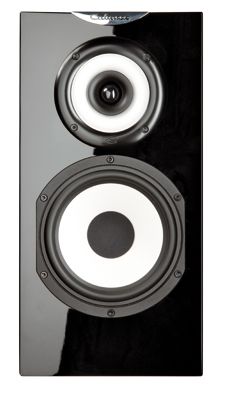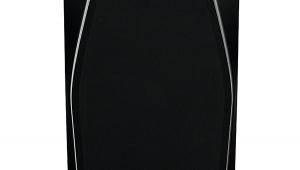Cabasse Minorca Mc40 (£759)

You’d scarcely credit that the MC40 Minorca is the cheapest speaker here. It’s larger than the ATC, Dynaudio and PSB, it has a piano black finish (a £140 cost option, standard finishes being cherry and purple cherry wood veneers) and, unlike all the others, it’s a three-way rather than a two-way design.
Cabasse’s distinctive BC10 coaxial driver is responsible for that last feature, comprising a soft dome tweeter, with shallow horn loading, surrounded by a convex annular diaphragm that handles the frequency range between 900Hz and 3.2kHz crossover points. This layout provides the improved vertical directivity of a coaxial driver without incurring the difficulties associated with having the tweeter at the apex of a midrange cone – although the lab tests indicate that integrating the two elements is still not easy. A 170mm bass-mid driver handles the remainder of the frequency range, aided by a small rear-firing reflex port. A powered subwoofer – the Mercure – is available for extending the response down into the lowest octave.
Although Cabasse recommends that the Minorca be used on 300-400mm stands and placed at least 200mm from nearby walls, there is some evidence from the lab test that its bass response has been tuned for use quite close to a rear wall.
WIDE AND DEEP
Without question, the MC40 Minorca’s sound is coloured and quite obviously so, to the extent that it could be called old-fashioned. Whether or not you like this speaker will be dominated by your response to this ‘character’. And while I enjoyed the Minorca’s essential openness, I found that to be a stumbling block.
The yin and yang of the sound were obvious on the first piece I played, the Kodály cello miniature. While the stereo image was wide and deep and the ardour of Natalie Clein’s playing never in question, there was a lack of precision in the reproduction that marred the illusion. In our Scheherazade excerpt the big, open nature of the Minorcas’ sound was again evident, although it was clear that they really needed to be close to the wall behind, to prop up their bass. Out in the room they lack low frequency weight (confirmed by ‘Come Together’). The coloration manifested itself here in the form of a not quite right massed violin sound and some hazing in the orchestral climaxes.
Eva Cassidy’s voice is already coloured on ‘Songbird’ by heavy-handed use of EQ but the Minorca sub added its own, further layer of fuzzy manipulation. This was less obvious in ‘The Dog Song’ but the hole in the Minorca’s presence band output took a little of the zip out of the spiky guitar transients.
Originally published in the October 2011 issue


























































